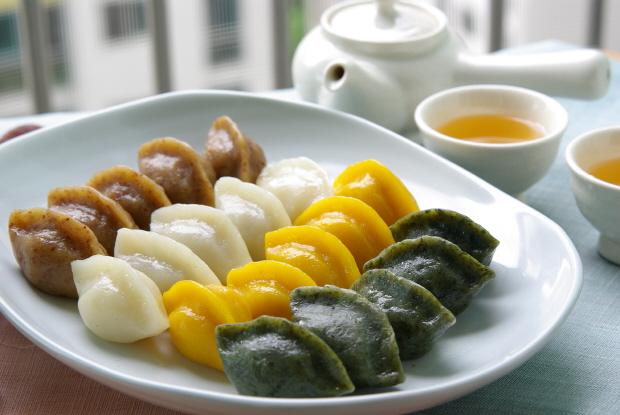Chuseok, also known as the Korean Thanksgiving or Mid-Autumn Festival. If the biggest holiday of the first half of the year is Seollal (설날, Lunar New Year’s Day), then the biggest holiday of the second half of the year is undoubtedly Chuseok (추석). This festival held on the 15th day of the 8th lunar month, which is September 30th this year. Chusok is often called a great day in the middle of August. It occurs during the harvest season. Thus, Korean families take this time to thank their ancestors for providing them with rice and fruits.
A traditional Chuseok table setting for ancestral rites
The celebration starts on the night before Chusok and ends on the day after the holiday. It is usually a three day holiday – something quite rare in Korea – emphasizing the importance of this holiday. People go back to their hometowns to get together with their families to tend the ancestors’ graves and give thanks to them through solemn ancestral rites.
Naturally, because it is a holiday celebrating the harvest, food becomes a central focus. Special Chuseok foods like songpyeon (송편), a kind of rice cakes made of rice, beans, sesame seeds, and chestnuts in crescent shapes with various fillings. The usual holiday foods of jeon (전) and japchae (잡채) also making an appearance.
songpyeon (송편)
Although called by different names depending on the era, Chuseok has been celebrated in Korea for centuries. Celebrating the harvest and the full moon also come hand in hand, as the full moon symbolizes fecundity and prosperity. Since the brightest and fullest moon is said to rise on Chuseok, it is more than reason enough for celebration. In the evening, children wear their favorite hanbok(한복 traditional Korean clothing). Among the traditional games played on Chuseok, the dance Ganggangsullae (강강술래) consists of people holding hands, singing and dancing in circles under the bright full moon.
In Korea, you can’t talk about the full moon without thinking about the rabbit. Mostly known that the full moon brings upon images of the “Man in the Moon” in some other country culture, but here, it’s the rabbit.
The rabbit
The rabbit in the moon is also called the “jade rabbit” (옥토끼), which is common in the folklore of not only Korea, but also China, Japan, and other countries. In Chinese folklore the rabbit is busily pounding a special medicine in a mortar for the Goddess of the Moon; in Korea, the rabbit is busily pounding rice to make tteok (떡, ddeok, rice cakes); in both cases, it is making an essence of life.
But why is there a rabbit in the moon? Legend says there once was a village where a rabbit, a fox, and a monkey resided. The three devoted themselves to Buddhism and spent much time in its study and practice. One day, the Emperor of the Heavens looked upon them and to test their faith, told them to bring him something to eat. The three set off to fulfill his wish. Consequently, the fox returned with fish, the monkey with fruit, and the rabbit, who could do nothing but gather grass, lit a fire with it and jumped in, offering his own self. His commitment earned the approval of the Emperor and he was placed in the moon as its guardian, with “smoke” surrounding him as a reminder of his endeavor.
This legend varies in different cultures: sometimes the Emperor of the Heavens is disguised as a poor old man, sometimes it’s not the three animals mentioned above but others. The actions of the rabbit remain consistent, however, and the results of his deed as well.
The image of the rabbit in the moon and the gyesu tree is so steadfast in Korean culture that it shows up in a famous children’s song, “Half-moon” (반달), which was written and composed by the songwriter Yoon Geuk-young (윤극영) in 1924. (The song is better known for its first verse and some people think it is the title, but it’s not.)
The lyrics are:
푸른 하늘 은하수 하얀 쪽배엔
계수나무 한 나무 토끼 한마리
돛대도 아니 달고 삿대도 없이
가기도 잘도 간다 서쪽 나라로
푸른 하늘 은하수 하얀 쪽배엔
계수나무 한 나무 토끼 한마리
돛대도 아니 달고 삿대도 없이
가기도 잘도 간다 서쪽 나라로
High above the deep blue sky, down the Milky Way,
Rides a ship without a sail, with no oars they say,
Ship of white, its only crew, is a rabbit white,
Westward it floats along, silently through the night
Rides a ship without a sail, with no oars they say,
Ship of white, its only crew, is a rabbit white,
Westward it floats along, silently through the night
Happy Chuseok, everyone! ^^
sources from:
http://blog.korea.net/?p=13278
http://kevdesign.com/midautumnfestival/korea.htm
By JY



Granicip 1mg Tablet is an antiemetic drug used to forestall nausea and vomiting brought about by chemotherapy, radiation treatment. It might likewise be utilized for the treatment and anticipation of nausea and vomiting related to medical procedures.
ReplyDelete